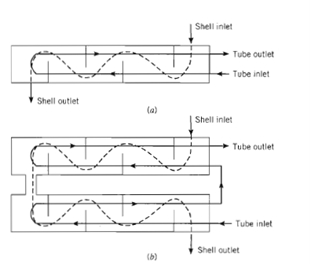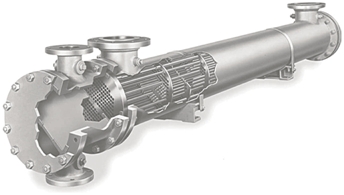Ageing in heat integration
Back to EFFICENCY FINDER OF FOOD INDUSTRY
GENERAL INFORMATION
Most commons are shell-and-tubes or plate heat-exchangers.
TECHNOLOGY DESCRIPTION, TECHNIQUES AND METHODS
Shell and tube heat exchangers
The shell and tube heat exchangers is configured as a bundle of tubes inside a shell. Specific forms differ according to the number of shell and tubes passes. Baffles are installed inside the shell to increase the convection coefficient and improve the heat transfer between fluids. The tubes are supported by the baffles and this way vibration due to the fluid circulation is reduced.
Illustration 1: Shell and tubes heat exchanger [1]
The shell construction allows this heat exchanger to be suited for higher-pressure applications. One fluids runs along the tubes and the other fluid runs over the tubes, conducted by the baffles and increasing the heat convection. The cross section of the inner tubes is rounded and the geometrical construction characteristics depends on the requirements of the heat exchange (pressure, temperature, flow rate, fluid, etc.)
Some configurations of the shell and tube heat exchanger are shown below:
Illustration 2: Shell and tubes heat exchanger [2]
Illustration 3: Shell and tubes heat exchanger [3]
Plate Heat Exchangers
Plate heat exchangers are systems that separates two air flows with solid elements (plates). The heat exchange occurs through the plates, which can be built with fins to maximize the contact surface and increase the exchange efficiency. Depending on the flows direction the system will be parallel flows or countercurrent flows. The plate heat exchanger efficiency is around 75% [4].
Illustration 1: Plate and Plate-Fin heat exchangers [5]
CHANGES IN PROCESS
The installation of a heat exchanger does not implies a change in the process, because the main aim of the measure is to harness wasted fluid (and wasted energy) and pre-heat or pre-cool an incoming fluid to the process. Therefore, process can be kept identical, and the heat exchangers affects the fluid in an early stage and when it already has came out from the process.
ENERGY SAVINGS POTENTIALS
CHANGES IN THE ENERGY DISTRIBUTION SYSTEM
REFERENCES
[1] Fundamentals of heat and mass transfer. Incropera, DeWitt, Bergman, Lavine
[2] Fundamentals of heat and mass transfer. Incropera, DeWitt, Bergman, Lavine
[3] Heat exchanger handbook. 2on edition. KuppanThulukkanam
[4] Fundamentals of Heating Systems. ASHRAE
[5] Fundamentals of Heating Systems. ASHRAE
- Case studies



